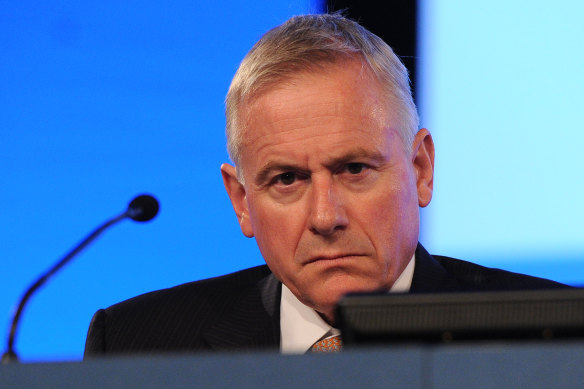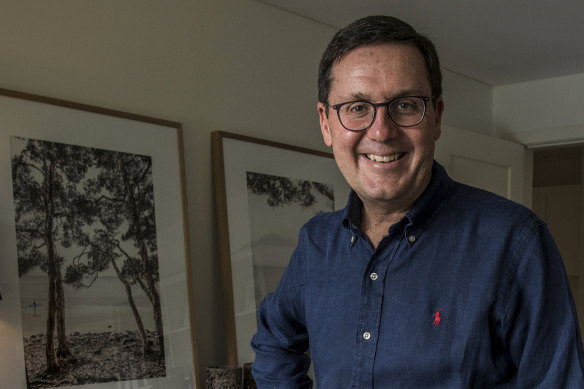
Ken MacKenzie prefers to be under the radar. The elusive chair of BHP, who apparently is having a 50-foot motor cruiser built on Victoria’s Mornington Peninsula, has been invisible during a bold $64 billion bid for rival Anglo American. He wants the limelight instead to be on his chief executive Mike Henry, as it should. In the past, larger-than-life BHP chairmen have dominated and overshadowed their chief executives. That MacKenzie has a restrained ego is admirable. Yet make no mistake, this mega-deal, if it comes off, is as much MacKenzie’s as it is Henry’s.
The deal, so far, has been rebuffed twice by Anglo’s board and management, who this week revealed their own radical restructuring plan. Investors are waiting to see if BHP makes a third tilt early next week to secure the deal, by increasing its all-share bid.
If it does, and is successful, the deal promises to set BHP up for growth over the next two to three decades, positioning it as the dominant miner in copper and metallurgical coal production and making it the third largest in iron ore and nickel. It would also shape MacKenzie and Henry’s legacies at the Big Australian.
“I can see why they’re going after the Anglo deal,” says Graeme Liebelt, a former Orica chief executive, who now chairs Amcor, and has worked with MacKenzie. “Having been in the mining industry myself, and seeing where things are headed with copper, you can see the strategic rationale.
“Mike Henry has a very good reputation, and Ken is very careful about these things. They would have thought it through thoroughly and will not be surprised by initial knock backs. But it is a complicated deal, it’s asking Anglo shareholders to take on a fair bit of risk. So, it’s going to be very challenging but maybe not impossible.”
The world’s biggest producers of copper, such as BHP, are keen to grow their footprint to take advantage of rising demand for the metal that’s being used in the manufacture of green energy grid infrastructure, from solar panels to wind farms, and also at data centres and in electric vehicles, like the Tesla that the 60-year-old MacKenzie drives.
Although MacKenzie, who originally hails from Canada, and speaks French and some German, is known to be more into boats than cars. He raced Lasers in national competitions in Canada in his youth earning him medals, and is having a motor cruiser built.
MacKenzie’s peers describe him as having one of the most formidable minds in business. He earned a reputation as a shrewd dealmaker, adept at brokering acquisitions and transforming businesses, as well as demonstrating strict control on capital spending, while working for three decades at Amcor. There he rose to become its chief executive, and was tasked with fixing the global packaging company after an inglorious cartel scandal.
“He hit the ground running,” recalls Chris Roberts, who was Amcor’s chair when MacKenzie was appointed CEO. “He took us through a whole series of what he called a ‘Get Fit’ program, which really meant getting rid of businesses we had around the place that were not working and really focusing on where we could grow. We expanded by acquisition largely over the next 10 years or so. He was outstanding.”
Liebelt, who succeeded Roberts as Amcor’s chair, agrees. He points to the 2009 deal when Amcor paid $2.4 billion to Rio Tinto for its Alcan packaging assets, which made it then the largest group globally in pharmaceutical and healthcare packaging. Amcor manufactures packaging items as varied as aluminium cans to lolly wrappers to cigarette cartons.
“Alcan was a carefully managed deal and the integration was very well done,” says Liebelt. “Amcor really learned something from how to do acquisitions from that point onwards. They took pains to make sure that the processes they put in place were repeatable, so they documented them, and did reviews. After that, when other acquisitions were done, and this still continues until this day, there’s a playbook for Amcor in making acquisitions.”

Graeme Liebelt, Amcor chair, who has worked with Ken MacKenzie, said the Anglo deal would be “very challenging but maybe not impossible”. Credit: Julian Smith
Liebelt describes MacKenzie as having a strong values’ system, and also as charming. “He does the homework and the hard yards, putting the right processes in place, finding the right people. He’s tough and clear as to what he expects, and follows through to ensure that things are being delivered.”
MacKenzie’s performance at Amcor drew the attention of BHP chair Jac Nasser, who tried to hire him to be the miner’s CEO, according to people with knowledge of the matter. MacKenzie declined.
Instead, he had his eye on another prize: Nasser’s job. MacKenzie finished as Amcor’s CEO in April 2015, and joined BHP as a director in September 2016. A year later he was chair of the mining group.
When MacKenzie replaced Nasser the biggest problem facing BHP was shareholders’ scepticism at the company’s ability to manage capital well, particularly when executing acquisitions - and for good reason.
Loading
BHP had burned nearly $US40 billion ($60 billion) on a disastrous foray acquiring and investing in shale oil and gas in the US, which began under CEO Marius Kloppers in 2011. BHP would later write down tens of billions on those assets, which would eventually be sold for a fraction of what was paid on that ill-fated bet.
But it wasn’t just that transaction that had shaken investors’ confidence. Successive management and boards at BHP have a chequered history of merger and acquisitions. More than two decades after BHP bought South Africa’s Billiton in what was supposed to be a transformational transaction, debate continues to rage about how much value was created and destroyed from that deal.
When BHP bought WMC in the mid-2000s, management and the board were accused of paying too much. And then there was management’s misadventures in trying to buy Rio Tinto, not once but twice, to try and create an absolutely unassailable group. It cost former BHP CEO Brian Gilbertson his job.
When MacKenzie became BHP’s chair he went on a listening tour of major shareholders. His engagement was well-received and differed, some say, to his predecessor. “If you had a one-hour meeting with Jac Nasser, he would spend 57 minutes of that meeting talking,” recalls one BHP investor, who asked not to be named.
Geoff Healy, who was previously BHP’s chief legal counsel and later responsible for managing the company’s reputation and non-financial risk until the end of 2020, said MacKenzie had firm views but listening was a key strength.

Geoff Healy, BHP’s former top lawyer, says: “BHP has needed growth and has wanted growth for a while now.”Credit: Steven Siewert
“He’s a clear thinker, a good listener, and has a unique capacity to see value, whether that’s in strategy, portfolio or capital allocation. He’s super disciplined in his execution. He’s also low-key.”
So low-key that MacKenzie declined to be interviewed. BHP’s management and board are shunning interviews as they tip-toe around the UK Panel on Takeovers and Mergers. Still, MacKenzie’s reticence towards media interviews existed well before the Anglo deal.
Healy says when MacKenzie stepped into the BHP chair role he had clear views about the company’s capital allocation framework and return on capital, and worked with management and investors to make sure this was transparent.
The framework focuses on investing in and extracting as much value from existing assets, maintaining a strong balance sheet, paying out at least 50 per cent of underlying profit in dividends, and with excess capital using it to either reduce debt, fund acquisitions, or undertake buybacks or pay higher dividends.
The capital allocation discipline is reflected in BHP’s metrics. Last financial year its return on invested capital was 29 per cent. In contrast, Anglo American’s was in the single-digits.
After MacKenzie’s arrival at BHP, management intensified their focus on simplifying the portfolio and company structure, while searching for growth - just like what occurred at Amcor.
In 2018, BHP exited its US shale oil and gas assets. In 2020, months before the pandemic struck, Mike Henry was appointed CEO, replacing Andrew Mackenzie.
In 2021, BHP announced it would collapse its dual-listed UK structure, consolidating into one company incorporated in Australia. It also abandoned a bidding war for Canadian nickel miner Noront Resources.
In 2022, the miner merged its petroleum business with Woodside. By 2023, it had exited some of its Queensland metallurgical coal assets that it owned jointly with Mitsubishi Development, in a deal worth up to $US4.1 billion. It’s had less success divesting thermal coal assets. That same year, it gave a green light to spending nearly $US5 billion on its Canadian potash operation.
BHP was also pursuing growth that year in metals, such as copper and nickel. It bought Oz Minerals for $US6.4 billion.
“It’s been a busy couple of years at BHP,” MacKenzie drily observed, in an interview with BHP’s media team last October.
BHP’s debt levels now sit at $US11.2 billion, which puts it towards the top end of its $US15 billion net debt ceiling cap.
In addition to his BHP role, MacKenzie has founded a program for ASX-listed chief executives at the Melbourne Business School, which he chairs. He’s also an advisor with investment bank Barrenjoey.
The chairmanship of BHP is a powerful one, which means few people are willing to criticise the record of MacKenzie or the company’s management publicly.
However, one senior business leader, who requested anonymity, made this observation. “Look at the whole nickel debacle. It seems no one realised in Australian mining that the Indonesians were getting Chinese companies to help produce nickel and flood the market. Where was the analysis? Why didn’t we know?”
The Anglo deal has been pitched as BHP buying growth, particularly in copper where demand is set to outstrip supply in the next decade. It would also offer significant synergies.
“Three of the largest copper producers are saying the copper price isn’t high enough. If that’s your conclusion, then clearly buying existing copper assets is a strategy that makes sense,” said George Cheveley, a portfolio manager at UK institutional investor Ninety One, which owns £675.6 million ($1.3 billion), or just over 2 per cent of Anglo. It also owns $665 million, or 0.3 per cent, of BHP shares.
“If you look at high-grade iron ore prices, met coal prices, which they would also get in this Anglo portfolio, there are pretty good arguments to say those long-term consensus prices are also too low.”
While Cheveley, who once worked for BHP as an analyst, wouldn’t reveal if Ninety One supported BHP’s deal or Anglo’s proposed break-up, he did say the synergies in putting the two companies together were “quite big” and the “fit was very good”.
A deal with Anglo would also address the imbalance in BHP’s portfolio. After the demerger of its petroleum division and the Oz Minerals acquisition BHP’s portfolio remained structurally challenged. Its iron ore operations dwarfed its coal, copper and nickel businesses.
The Anglo deal, where BHP would acquire most of that group’s iron ore and copper assets, while divesting of its platinum and diamond businesses, would fix this. Though the deal’s complicated, multi-step structure makes it risky, as do the political and regulatory challenges.
Loading
Geoff Healy isn’t surprised by BHP’s pursuit of Anglo. “BHP has needed growth and has wanted growth for a while now. What Mike and Ken have done, building on the work Andrew and Ken did, is to run the place safely, get the assets operating well, clean up the portfolio, simplify the corporate structure, and put down some growth bets. The narrative around Anglo is not that this is Mike or Ken’s deal.”
Others may beg to differ. But for Healy, it’s a far simpler proposition. “It’s just that they would have looked at this period and said it’s the right time, we’ve set the place up to be ready for it.”









 Add Category
Add Category